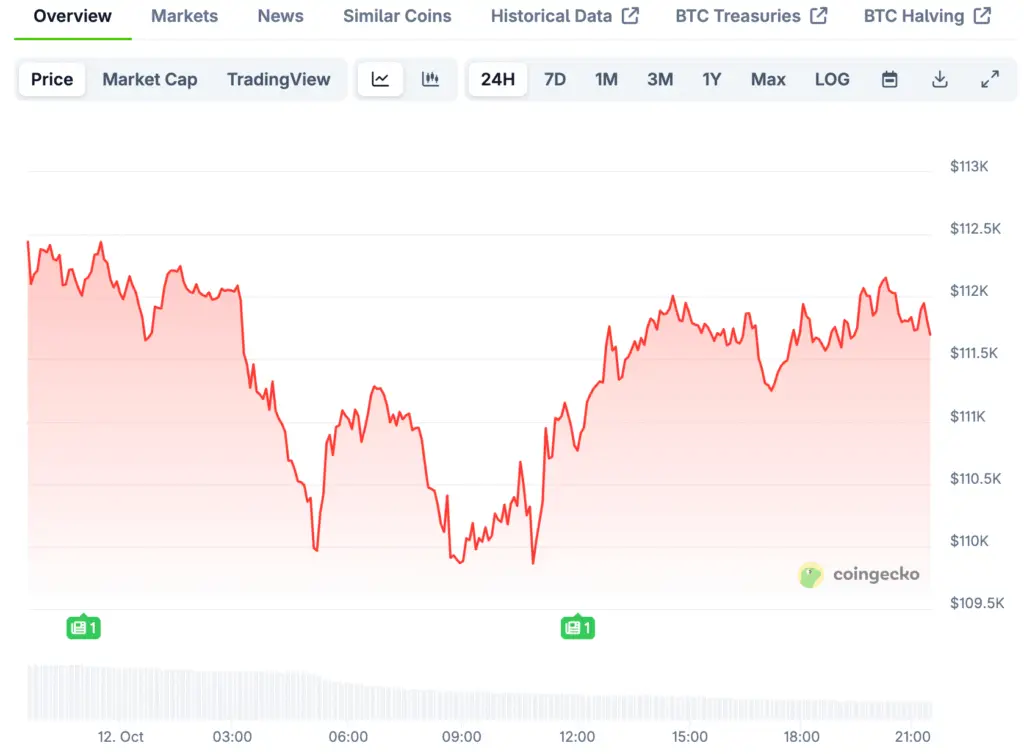Trade Tensions Between United States and China Shake Global Markets Severely
The abrupt decline in Bitcoin’s value is a direct result of rising trade tensions between the United States and China, which have swiftly unsettled investor confidence. President Trump took to Truth Social to announce retaliatory measures following China’s announcement of extensive export restrictions set to begin on November 1, 2025.
Markets responded swiftly with extensive selling as traders assessed the ramifications of concurrent tariff and export control measures. The implementation of these policies poses a significant risk to essential supply chains linked to defense semiconductors and the artificial intelligence sectors, exacerbating the overall global economic uncertainty.

Bitcoin Suffers Sharp Pullback Amid Growing Macroeconomic Instability Worldwide
Bitcoin plummeted from 117,000 earlier in the afternoon to below 108,000 within hours, underscoring its sensitivity to geopolitical events. High-frequency traders heightened volatility, leading to liquidation cascades throughout derivatives and spot markets during the sharp decline phase.
Currently, Bitcoin has shown a slight rebound near 113,000, but the price action continues to exhibit significant instability. Experts caution that ongoing volatility may continue as investors evaluate the wider effects on liquidity movements and the levels of institutional demand.
Broader Financial Markets Experience Coordinated Sell-Off Across Major Indices
Equity markets reflected the downturn in cryptocurrency, with the S&P 500 declining by 2% and the Nasdaq dropping by 2.7%. This simultaneous decline highlights the growing connection between digital assets and global macro risk sentiment during times of heightened uncertainty.
The sudden cancellation of the APEC meeting with Xi Jinping by Trump has heightened tensions, indicating significant diplomatic divides are emerging. Concerns among investors are growing that deteriorating relations could lead to prolonged trade disruptions, significantly affecting technology manufacturing and the global movement of commodities.
Recommended Article: Trump Becomes Major Bitcoin Investor With $870 Million Holdings
China’s Export Controls Intensify Pressure on Critical Supply Chains Globally
Beijing has broadened its export policy to encompass all foreign-made products that incorporate Chinese rare earth components or materials in a general sense. These limitations pose a direct risk to the semiconductor and defense industries, which depend on specialized components obtained from Chinese industrial networks that have been established over time.
The resulting shock prompts critical inquiries regarding the resilience of resource allocation and the dependencies of global production as we move forward on an international scale. Numerous corporations might hasten their diversification strategies by relocating manufacturing bases to reduce vulnerability to the growing unilateral geopolitical risks.
Bitcoin’s Decline Sparks Turbulence for Publicly Traded Crypto Firms, Including Coinbase
Crypto firms listed on the stock market faced significant intraday declines, mirroring the sudden market drop of Bitcoin and its ripple effects. Coinbase, MicroStrategy, Robinhood, and Circle experienced losses fluctuating between 3% and 12% during turbulent trading sessions.
Investors viewed these actions as validation of the systemic risk associated with blockchain-related equities that reflect the volatility of digital assets. Experts indicate that changes in regulations and overarching economic stories are consistently influencing the mood in both cryptocurrency markets and associated stocks at the same time.
Analysts Highlight Bitcoin’s Long-Term Bullish Context Despite Near-Term Volatility
Even with a brief correction, Bitcoin is still over 30% higher year to date, driven by robust ETF inflows and increasing adoption. Experts characterize this event as a consolidation phase within a broader bull cycle, typically marked by short yet intense corrections in recent times.
In the past, comparable declines have often come before a resurgence, paving the way for euphoric periods where prices surge toward key psychological thresholds with notable intensity. Projections suggest that maintaining a trajectory toward the 180,000 to 200,000 range is feasible, provided that global macroeconomic stability is restored in the near future.
Bitcoin’s Institutional Support and Strong Network Metrics Reinforce Long-Term Growth Outlook
Market strategists advocate for patience, highlighting Bitcoin’s growing institutional support and robust network metrics that underpin its long-term growth potential. Temporary geopolitical shocks seldom change the fundamental adoption trends that are consistently bolstered by ETF demand and the ongoing momentum of infrastructure investment.
With uncertainty diminishing, Bitcoin could bounce back more swiftly than conventional markets, reinforcing its position as a decentralized store of value. Traders keeping an eye on on-chain data and capital inflows are feeling hopeful about stabilization as macro volatility diminishes globally.















